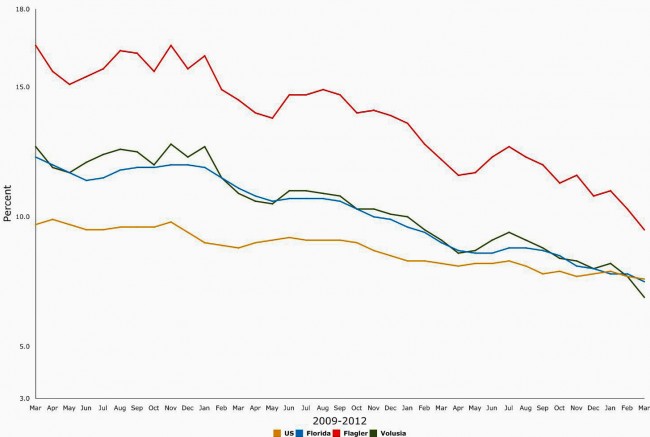
Last Updated: 11:49 a.m.
For the first time since June 2008–almost five years–Flagler County’s unemployment has fallen back to single digits, registering 9.5 percent in March as the local economy continued to mirror the state’s and the nation’s, improving slowly but steadily. Flagler’s numbers in march were a sharp improvement over February, when the unemployment rate was 10.3 percent.
As in February, the drop in Flagler’s unemployment was led by a net increase in jobs rather than by a decrease in the number of people in the labor force or the number of people looking for work, suggesting again that the economy is gaining organic strength. In many previous months, the unemployment rate had fallen rather artificially, only because people were dropping out of the workforce or the county was losing people of working-age. That trend appears to be over.
In March, there were 301 more people with jobs in Flagler, while the labor force increased by just 23. There were 278 fewer people on the unemployment roll, for a total of 3,316 people without work in the county. That compares with 4,190 people without work a year ago.
“I always try to look at trends because one month is just a snapshot in time,” says Beau Falgout, Palm Coast’s senior economic development planner. And it’s been a positive trend since the peak in 2010, he points out, with 2,000 fewer unemployed since that peak. “There’s about 4,100 more employed than that low number we hit, so both those numbers are going in the right direction.” The current unemployment rate is still too high, he notes, but foreclosures are down, housing starts are up, bed tax and sales tax collections are up. “That’s good, positive news,” Falgout says, all pointing in the right direction.
“I wish I could say every job that was created was because of the city but there’s a lot of people involved in economic development,” Falgout said. “We’ve had an effect but it’s part of a greater effort and a the end of the day it’s the private sector that creates those jobs.”
Helga van Eckert, the county’s director of economic development relayed the following statement through Kristina Bowen, her project manager: “We’re pleased to see and encouraged that the unemployment situation continues to improve. We’re focusing our efforts and continue to work toward achieving a slow, steady progress in this area.”
In Florida, the unemployment rate fell to 7.5 percent, the lowest level since November 2008. There were 7.5 million employed Floridians, an increase of 32,000 jobs over the month–one of the better monthly net increases of the past two years. There were 706,000 Floridians officially without work. The number does not include those who have dropped out of the workforce, or the under-employed, who work part-time because their hours were cut or because they can’t find full-time work. By the end of 2012, when those individuals are included, Florida’s rate of unemployed or under-employed was 16 percent, according to the federal Bureau of Labor Statistics, 7th worst in the nation.
Hendry County had the highest unemployment rate in Florida at 10 percent in March 2013, followed by Flagler, Putnam (9.4 percent), Miami-Dade (9.2), and St. Lucie (8.8). Hendry had the highest unemployment rate in the state mainly due to long-term losses in state government jobs. Hendry is now the only county in Florida with a double-digit unemployment. Monroe County’s 3.8 percent unemployment rate was the lowest in the state, followed by Walton County (4.3 percent), Okaloosa (4.8), Alachua (5.1), and St. Johns (5.3 percent). Many of the counties with the lowest unemployment rates were those with relatively high proportions of government employment. Strong population growth was also a contributing factor.
The Center for Business Excellence in Daytona Beach summarized the employment situation for Flagler and Volusia counties as follows:
The unemployment rate in the Flagler-Volusia region was 7.2 percent in March 2013, the lowest since June 2008 when it was 6.7 percent. The March 2013 rate was 2.2 percentage points lower than the region’s year-ago rate.
In the Palm Coast metro area, nonagricultural employment was 20,200 in March, down 100 jobs over the year, while statewide, employment increased by
1.9 percent over the same time period.Two of the ten major industries gained jobs over the year, professional and business services (+200 jobs) and leisure and hospitality (+100 jobs). Manufacturing, information, other services, and government (-100 jobs each) lost jobs over the year. Professional and business services (+9.5 percent) employment grew faster in the Palm Coast metro area than in the state. The Palm Coast metro area had the second-highest employment growth rate in professional and business services (+9.5 percent) for all metro areas in Florida.
In the Deltona-Daytona Beach-Ormond Beach metro area, nonagricultural employment was 161,100 in March, up 3,300 jobs (+2.1 percent) over the year. Nine of the ten major industries gained jobs over the year, led by leisure and hospitality (+1,300 jobs); trade, transportation, and utilities (+1,200 jobs); professional and business services (+400 jobs); financial activities (+300 jobs); mining, logging, and construction, manufacturing, and education and health services (+200 jobs each); and information and other services (+100 jobs each). Government (-700 jobs) was the only industry losing jobs.
![]()
Flagler and Florida March Unemployment Report





























Gia says
It would be naive to think the improvement is that great. More people are seeking employment somewhere else.
audra says
The drop is only because you can only receive unemployment for 6 months, that doesn’t mean those people have found jobs. It has just taken them off the list of unemployed.